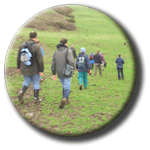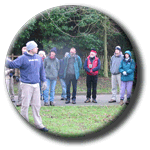How to Lead Guided Walks
G
uided walks are an important method of interpretation in the countryside and
elsewhere, and giving a good walk is an important skill for anyone wishing
to promote a countryside site or project. The traditional guided walk has
many variations, but there are some basic principles which apply where ever
you are. The following guidelines are based on those devised for use by local
authority ranger staff leading guided walks in an urban fringe countryside
project.
Guided walks are often one of the occasions when many people first visit a
site. It is important that all guided walks work as well as possible, and are
a good first experience to encourage visitors to return. This includes both
public guided walks and those done for particular groups.
 Publicity
is crucial. Posters, a sign at the meeting point, and other means are all useful.
By far the best method, however, is to link up with (or start) a regular series
of walks, such as those often led by the Health Authority or the Ramblers. This
can give you a ready-made audience. It's useful, if you can, to organise the
events regularly, eg every second Wednesday or something, so people get in the
habit of coming. If you have a series of walks you can produce a leaflet, and
distribute it via Tourist Information Centres etc. This tends to be more successful
than a number of individually organised walks. Be sure that your publicity,
whatever it is, includes at least the following:
Publicity
is crucial. Posters, a sign at the meeting point, and other means are all useful.
By far the best method, however, is to link up with (or start) a regular series
of walks, such as those often led by the Health Authority or the Ramblers. This
can give you a ready-made audience. It's useful, if you can, to organise the
events regularly, eg every second Wednesday or something, so people get in the
habit of coming. If you have a series of walks you can produce a leaflet, and
distribute it via Tourist Information Centres etc. This tends to be more successful
than a number of individually organised walks. Be sure that your publicity,
whatever it is, includes at least the following:
• What the event is
• Where it is?
• When (date, time and day of week)?
• How long it lasts.
• How to get there.
• Contact number for leader.
• Any special requirements, eg boots, binoculars, no dogs.
 You may also want to consider a press release, even if you
have done all the above. See Naturenet's page
about press releases
You may also want to consider a press release, even if you
have done all the above. See Naturenet's page
about press releases for
more ideas. Always turn up at the advertised meeting point despite the worst
weather. Run the walk if there is one person or more who wants to go on it
- even if that does not include you! Arrive at the meeting point at least
10 minutes beforehand, and leave the meeting point between five and ten minutes
after the advertised time. Guided walks aimed at first-time walkers should
normally last 1½-2
hours, be over easy terrain, and be about 2 miles walk at the most. If the
walk is aimed at those with more experience or taste for adventure, the sky
is the limit - but be sure that you advertise it with this in mind.
for
more ideas. Always turn up at the advertised meeting point despite the worst
weather. Run the walk if there is one person or more who wants to go on it
- even if that does not include you! Arrive at the meeting point at least
10 minutes beforehand, and leave the meeting point between five and ten minutes
after the advertised time. Guided walks aimed at first-time walkers should
normally last 1½-2
hours, be over easy terrain, and be about 2 miles walk at the most. If the
walk is aimed at those with more experience or taste for adventure, the sky
is the limit - but be sure that you advertise it with this in mind.
To start off with there are a number of things which should
be said, even if many of the group have been out with you before some might
not have.
• Introduce yourself, giving your name and job title if you have one.
Introduce any other members of staff present if they want to be introduced.
• Welcome the visitors to the place/project, on behalf of your employer
and/or the site owner if you are doing it for them. If the project is sponsored
or supported by any organisation they will probably appreciate a mention too.
• Explain what the theme of the walk is, if there is one, and how long
it will last. Be sure to keep to this time!
• Give a warning if there is likely to be any rough going, e.g. if it
is muddy. This is especially relevant if you see someone with a pushchair or
unsuitable shoes - if they are warned and still come then they cannot complain
afterwards.
• Before you set off, give a brief description of the route you will take
and assure the visitors that they will end up back where they started.
• If appropriate, point out that the walk is entirely free, and no payment
will be expected. Mention your employer again at this point for maximum advert
factor!
• Give out site leaflets, and any other relevant leaflets. If you have
them and there is no wind, it can be good to spread a range out on a van and
let people choose.
• Give a small trailer for any up and coming events and for the next guided
walk.
• Thank the visitors for coming, and encourage them to come again.
This is particularly relevant if you work for a charity,
local authority or other public body. Be very careful to say nothing which you
would not be prepared to say in front of anyone, including your employers or
the press.
• Make no political statements.
• Do not give personal information about other members of staff, or yourself
ideally.
• Tailor your tone to your audience - usually it is a 'family show' and
should be kept at that level.
• Do not make promises or wild speculation about future developments at
the site, unless you state clearly that it is only speculation.
• Do not be anything other than polite about other people, such as surrounding
landowners, or other official bodies - they may be amongst your audience too.
All walk organisers should ideally take all possible precautions
to guard against accidents on guided walks. in practice this is not always
possible. There is some doubt about who is liable in law if someone is injured
on a guided walk, and insurance cover does vary so if you have any concerns
you should contact
your insurers (or treasurer's dept) and ask them about third party liability
in such a situation. They should be able to clarify the situation as it applies
to you, and reassure you. Usually insurance for a local authority will extend
to volunteers leading walks by arrangement with the council, too.
It is certain that if a member of staff takes member of the public into danger,
it would be negligent not to warn them, and give the option of not going. Do
not normally take guided walks along anything but the most sensible paths.
In cases where someone would obviously not be suitable for the route, such
as a frail old person, it is quite acceptable to tell that person that the
walk would not be suitable for them. If they come, that is their choice.
One member of staff is the minimum requirement for a guided walk. When events
get popular and involve more than about 20 people, it is time to think about
getting more people to help. Here is a table giving suggested numbers of staff
and volunteers for public events. It has no legal force and is merely a suggested
ratio based on experience. The difference between 'staff' and 'volunteers'
will also depend on the sort of project you work for. Sometimes volunteers
are the best leaders and know more about the site than paid staff. For these
purposes, think of staff as people familiar with the site and its work, and
volunteers as people who've just come along to help but don't necessarily know
much about the place.
Number of walkers |
Members of Staff |
Volunteers |
1-20 |
1 |
or 1 |
20-60 |
1 |
1 |
60-100 |
1 |
3 |
100-150 |
2 |
5 |
150+ |
3+ |
6+ |
NB These are minima. More is better.
Volunteers can be very helpful on larger guided walks. Make sure they can be
identified, either by uniform or armbands or similar. Point these out at
the start of the walk as people who can be asked for help.
Duties could include the following, and will obviously depend upon the nature
of the location and event:
• marshalling car parking if necessary;
• directing stragglers;
• helping the infirm or those with pushchairs etc over obstacles;
• generally answering questions;
• shouting 'speak up!' when necessary;
• helping with specific preparations such as 'Ghost Walk' activities.

 Publicity
is crucial. Posters, a sign at the meeting point, and other means are all useful.
By far the best method, however, is to link up with (or start) a regular series
of walks, such as those often led by the Health Authority or the Ramblers. This
can give you a ready-made audience. It's useful, if you can, to organise the
events regularly, eg every second Wednesday or something, so people get in the
habit of coming. If you have a series of walks you can produce a leaflet, and
distribute it via Tourist Information Centres etc. This tends to be more successful
than a number of individually organised walks. Be sure that your publicity,
whatever it is, includes at least the following:
Publicity
is crucial. Posters, a sign at the meeting point, and other means are all useful.
By far the best method, however, is to link up with (or start) a regular series
of walks, such as those often led by the Health Authority or the Ramblers. This
can give you a ready-made audience. It's useful, if you can, to organise the
events regularly, eg every second Wednesday or something, so people get in the
habit of coming. If you have a series of walks you can produce a leaflet, and
distribute it via Tourist Information Centres etc. This tends to be more successful
than a number of individually organised walks. Be sure that your publicity,
whatever it is, includes at least the following: You may also want to consider a press release, even if you
have done all the above. See Naturenet's
You may also want to consider a press release, even if you
have done all the above. See Naturenet's